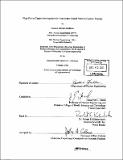High-power target development for accelerator-based neutron capture therapy
Author(s)
Blackburn, Brandon William
DownloadFull printable version (9.858Mb)
Other Contributors
Massachusetts Institute of Technology. Dept. of Nuclear Engineering.
Advisor
Jacquelyn C. Yanch.
Terms of use
Metadata
Show full item recordAbstract
The production of clinically sufficient dose rates in Accelerator-based Neutron Capture Therapies (ABNCT) requires targets that can withstand ion beams of 2-10 kW or higher. Designing such a target requires knowledge of the current density profile which can exceed 1 mA/cm². A method has been developed to quantify the two-dimensional current intensity by utilizing the positrons emitted from the products of either the ¹²C(d,n) or ¹¹B(p,n) reaction. A desktop scanner was used to convert the dose profile measured with MD-55-2 radiochromic film into a map of beam current intensity. Analytic calculations coupled with Monte Carlo methods determined the resolution of this technique to be 0.22±0.01 mm. Liquid gallium metal was investigated as a possible coolant. Qualitative and quantitative comparisons between single submerged impinging jets of liquid gallium and water at low flowrates were supplemented with computational fluid dynamics. Experiments using an array of submerged jets were conducted to determine area-averaged Nusselt number correlations for water and gallium over a Reynolds number range of 7000<Re<38000. The spreading factor, β[sub]max, was introduced into the gallium correlation to account for surface wetting effects. Area-averaged heat transfer coefficients, h, produced by an array of gallium jets were found to exceed those of water for Re>13500. At a Reynolds number of 35000 an h of 10⁵ W/m²K was measured with the gallium array compared to 5.5xlO⁴W/m²K for water. Simulations of the thermal and mechanical stresses found that a gallium-cooled beryllium target could withstand beam powers of up to 20.2 kW. (cont.) Because of its low melting-point, lithium targets were able to achieve 10 kW only if the beam power density was kept below 11.6 MW/m². No significant difference in figures of merit used to characterize neutron beams for ABNCT were found when water was replaced by liquid gallium as the cooling fluid.
Description
Thesis (Ph. D.)--Massachusetts Institute of Technology, Dept. of Nuclear Engineering, 2002. Includes bibliographical references.
Date issued
2002Department
Massachusetts Institute of Technology. Department of Nuclear Engineering; Massachusetts Institute of Technology. Department of Nuclear Science and EngineeringPublisher
Massachusetts Institute of Technology
Keywords
Nuclear Engineering.